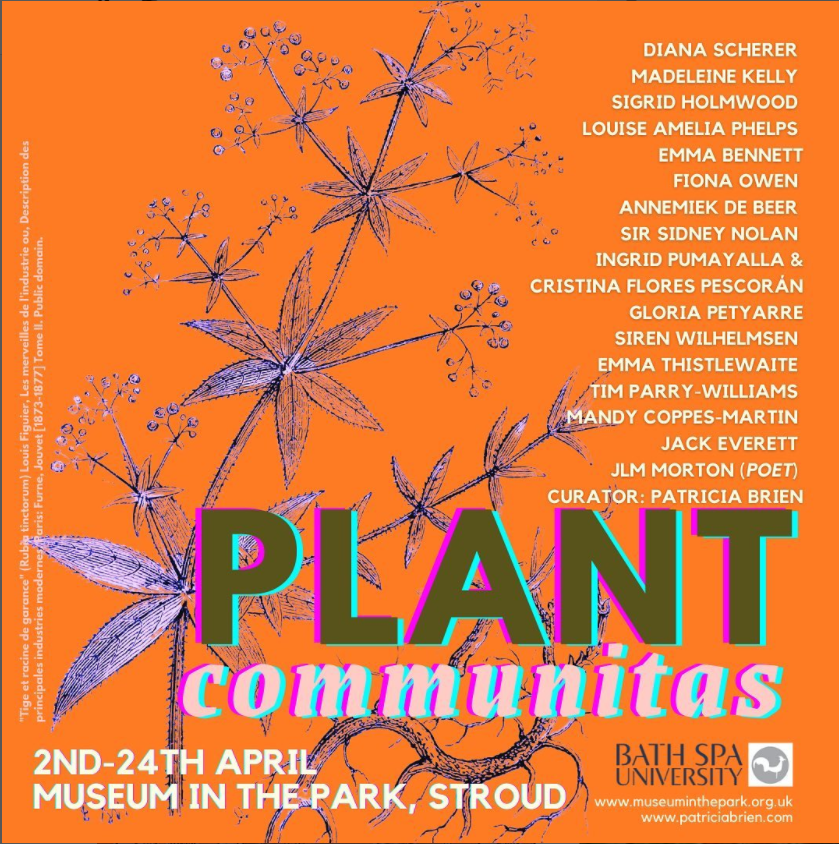Plant Communitas
Communitas [kɔmˈmuːnɪt̪äːs̠] is a Latin noun which refers to an unstructured community in which persons are equal, it also signifies the very spirit of community. The Plant Communitas exhibition considers plants and their active engagement in the human spheres of the everyday, the imagination, medicinal and mystical traditions and eco-political spheres. It focuses on the ‘backgrounded’ world of vegetal beings, infinitely intertwined in the human lifeworld (Patricia Brien, Curator, Plant Communitas).
I used to drive, age 18 or so, from Ciren to Minch and drop my best mate off at her bass player boyfriend’s house near Blue Boys on what was then thought of as the ‘new’ estate. I have driven that hinge of high land thousands of times, at all hours of the day and night, throughout the seasons and the years.
After digging through the archives researching poems, every time I drive that road now, I think of the blue boy dyers who worked with woad, and later, indigo to dye the broadcloth and the pub that was named after them. The boys reputedly walked the streets after work stained blue. Blue ghosts. And that was where this poem started, as a kind of haunted nostalgia daydreaming.
I was thinking about all that when I dipped my brush in fresh indigo and painted it on the wall at the Museum in the Park for the Plant Communitas exhibition curated by the visionary and brilliant Patricia Brien. I was thinking too of the little girl who was abandoned at the pub in the early hours of an August morning in 1730, of the horse fairs that went on there for over 500 years from late c13th through to late c18th, of the prisoners locked up in the Town Pound adjacent, of the ‘flying carriages’ that stopped at Blue Boys on their way to London. This was a place of commerce, carnivalesque and transition. The blue boys were master dyers and traders in slave produced indigo from plantation economies in the southern American states. The first known record of indigo on sale in Stroud is from mercer Thomas Bubb in 1650. So many stories.
‘Blue Boys’ takes its cue from the old pub sign that was painted in the late eighteenth century at the peak of indigo imports to Europe from the colonies. The sign is held in the Museum’s ‘Industry and Invention’ gallery – the pub eventually closed in 1866. Indigo is an ancient dyestuff – there is evidence of it from the third millennium BC on the borders of Egyptian mummy cloth and archaeologists have recovered Indigofera seeds dating to the second millennium BC from present day Gujarat. The Greeks and Romans imported indigo from India as a luxury good and for many centuries, India was a primary (but not the only) source of the world’s indigo.
Enslaved people harvesting indigo on a South Carolina plantation C18th
The first planter to successfully grow indigo in the American colonies was Eliza Lucas Pinckney, born 1728 in Antigua to a British Army Colonel. After many failed attempts, Pinckney was eventually successful in growing and processing indigo with the expertise of an indigo-maker of African descent recruited from the French West Indies. As a result, indigo became second only to rice as South Carolina’s commodity cash crop and accounted for over a third of the value of all exports from the American colonies. As testament to the quality of the indigo dye that could withstand all weathers, the Blue Boys Inn sign bears the inscription:
‘Though we stand here in wind and rain, true blue will never stain’
The Blue Boys Inn sign, Museum in the Park
I have painted my poem on the wall of Gallery One at the Museum, using ethically produced indigo from Japan. It is an almost unbelieveable privilege to be able to do this and it was a challenge to the poet for whom form and precision is everything and who is used to seeing neat lines on a page… but I loved it and find the conversation between artworks in the gallery, between oil paint and textiles, illuminations and film, embroidery and words, illuminating and thrilling.
My poem, ‘Blue Boys,’ on the wall of Gallery One
There are many stunning artworks in the exhibition – go! It is a startling and thought-provoking exhibition about our relationships with plants. A must see.
On now until Sunday 24th April 2022, plus there are some fascinating side events happening online and in person. I will be reading at the closing event 2pm on Sunday 24th April alongside performances from artist Ingrid Pumayalla and performance practitioner Brenda Waite.
Plant Communitas, Museum in the Park, Stratford Park, Stroud, Gloucestershire, GL5 4AF,
Artists: Emma Bennett, Diana Scherer, Madeleine Kelly, Sigrid Holmwood, Louise Amelia Phelps, Gloria Petyarre, Fiona Owen, Annemiek de Beer, Sir Sidney Nolan, Ingrid Pumayalla & Cristina Flores Pescorán, poet JLM Morton, Siren Wilhelmsen, Emma Thistlewaite, Tim Parry-Williams, Mandy Coppes-Martin, Jack Everett
Plant Communitas installation day






